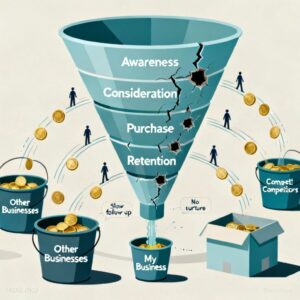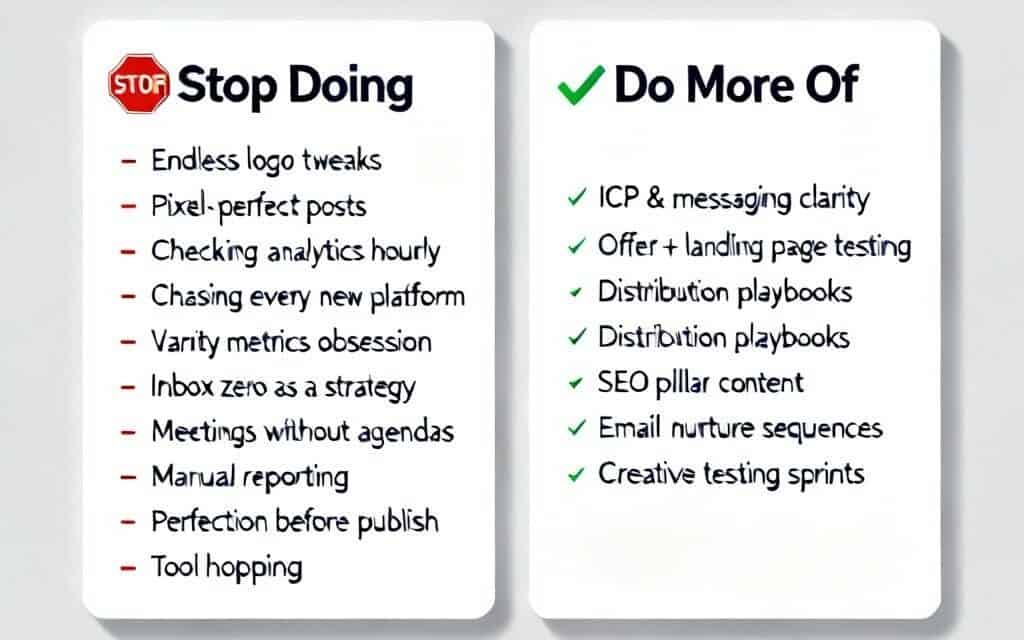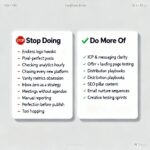Every Marketer Needs a “Stop-Doing” List to Scale Smarter
Most online marketers obsess over to-do lists. You stack tasks, check boxes, and feel productive—until you realise you’re still drowning in busywork and not moving the needle. That’s where a “stop-doing” list comes in. Instead of tracking what to add, you deliberately track what to cut. The goal: reclaim time, focus, and energy for the work that actually builds your business.
Your stop-doing list should include tasks to eliminate, automate, or delegate. Eliminate the things that don’t bring results—like endless low-value meetings or updating reports no one reads. Automate repetitive tasks like email sequences, billing, or content scheduling. Delegate time-sucking work like bookkeeping, customer support, or admin tasks that someone else can do faster (and cheaper). Every item you stop frees up bandwidth for the high-impact activities only you can drive: building your brand, growing your list, and creating offers that convert.
Think about it this way: every “yes” you give to small tasks is a “no” to strategic growth. A stop-doing list flips that script. It keeps you accountable to what matters and protects your energy from burnout. The best part? It’s not static. Keep your stop-doing list visible, revisit it weekly, and add new items as you go. Over time, you’ll notice more clarity, more creative space, and more momentum.
Jim Collins once said, “A great piece of art is composed not just of what is in the final piece, but also of what is absent.” The same is true for great businesses. Your growth isn’t just about what you do—it’s about what you decide not to do. Start your stop-doing list today, and watch how quickly your focus sharpens and your results multiply.
The Affiliate’s Stop Doing List
Some self-examination, here, and – happily – some habits that I have cured.
-
- My biggest mistake until recently was that I was using a ‘leaky funnel’, where I was including and, by default, promoting businesses I didn’t want to promote. Click to see how I fixed my leaky funnel.
- Overpaying for an auto-responder when LeadsLeap is available free, or for a low fixed monthly price, if you want the Pro features.
- Spending time doing jobs I’m not good at and don’t enjoy. I now have my TikTok videos created for me – learn how here (or there is a DIY option).
- I must stop being a perfectionist. No affiliate link for that one. Could be worth a fortune!
- Penny-pinching. Just this weekend I have wasted hours because I can’t get compatible cartridges to work on my printer. Lesson learned. The printer manufacturers beat me every time. Going forward, I will pay for their expensive ink. Life’s too short. A blogging related penny-pinch from many years ago, was to go for cheap, shared hosting. That cost me BIG time. I’m now with Wealthy Affiliate.
- Starting over and over again. I have some great businesses that have been on the scene for years. Why chase after a shiny object that may not be here in 6 months time?
- Chasing every latest AI tool. I found a handful that work, and I’m sticking to them. Insider preview here if you wish.
- Of special note is my AI tool: Abacus Much as I love and recommend Canva, I used to spend ages jiggling about with it and still end up with images looking like a dog’s dinner. In contrast, Abacus is just $10 a month and quickly comes up with images that almost always capture exactly what I had in mind.
- In fact, Abacus came up with a pretty good ‘stop doing’ list all by itself. It just gets better every day I use it.
- ‘Too busy’ optin pages, and endless tweaking of them. Simple is often best.
What I Should Have Done
This would make a great lead magnet! I probably will, so if this post disappears – that’s why.
Meantime, enjoy my confessions, and add your own in the comments.













